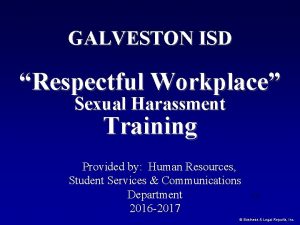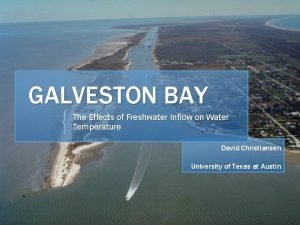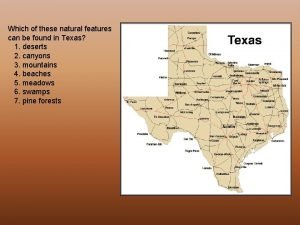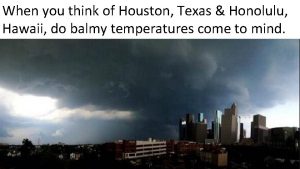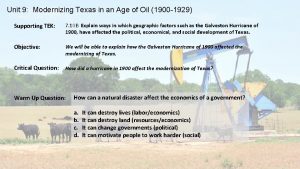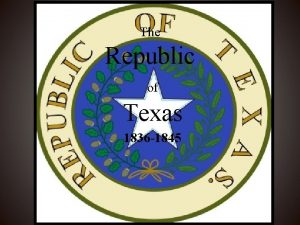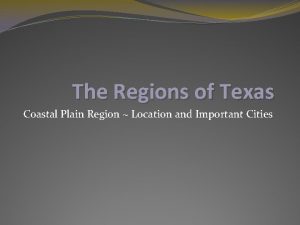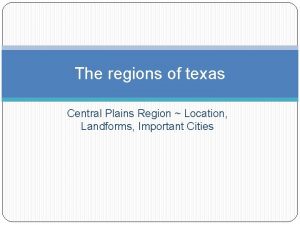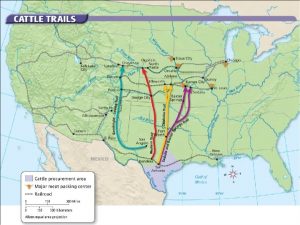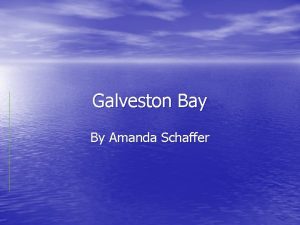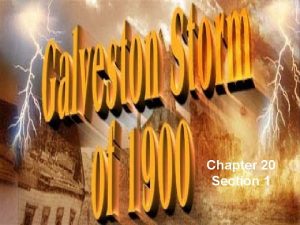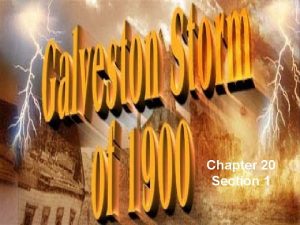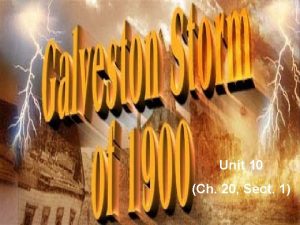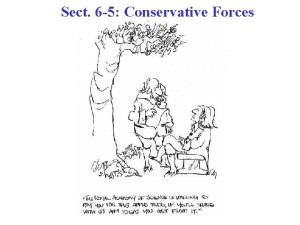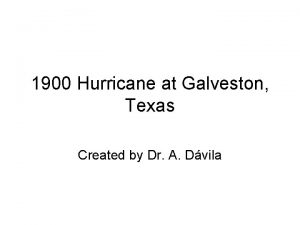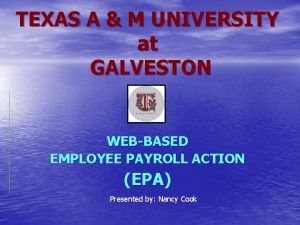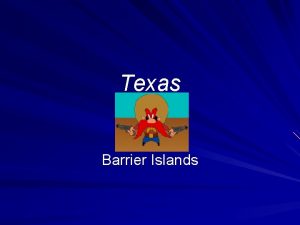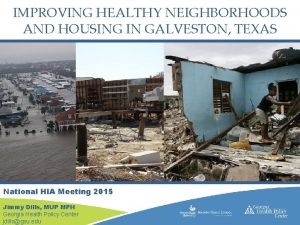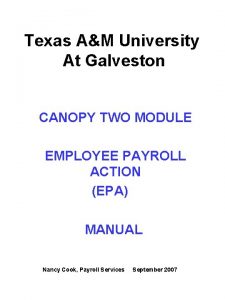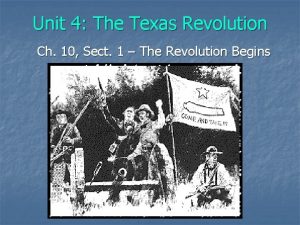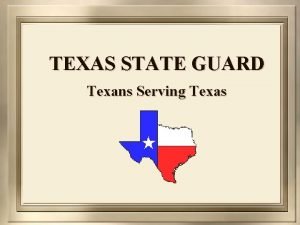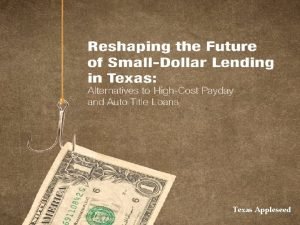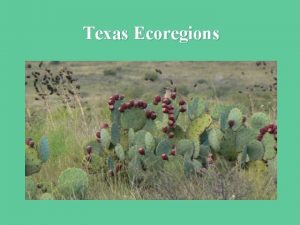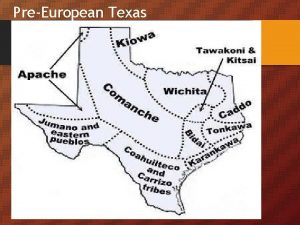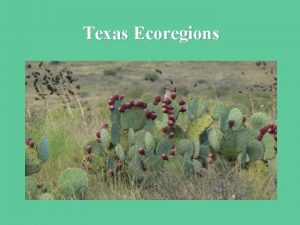Unit 10 Ch 20 Sect 1 Galveston Texas



























- Slides: 27

Unit 10 (Ch. 20, Sect. 1)

Galveston, Texas: Basic Facts • Galveston is located on Galveston Island • Galveston has been the home to – Native Americans (Karankawas) – Pirates (Jean Laffite) – Revolutionary Governments (Ad interim) • Began in April of 1838


Galveston, Texas: Basic Facts • Mexico used Galveston as a port due to its naturally deep harbor. • In 1800 s Galveston was a center for Cotton shipping for Texas and the U S. • Largest city in Texas from 1870 -80 – 22, 248 people

“Wall Street of the Southwest” • During the late 1800 s Galveston was Texas’ most refined city. • Galveston enjoyed its role as the financial center of Texas, a true White. Collar City. • First Texas city to have: – electric lights – telephone – baseball team

September 1900 • By early September 1900, citizens of Galveston hear about a storm in the Gulf of Mexico • Did not know how powerful it was • Most citizens disregarded the warnings given by Dr. Isaac Cline

September 1900 • Dr. Cline notices unusual swells in the gulf as he makes his rounds, but nothing signaling what’s to come. • Dr. Cline received messages from the Weather bureau as Galveston had been put under a storm warning as early as Sept 4. • Galveston’s 38, 000 residents go to sleep that night unaware of the fate that awaits them

1900 Storm Path

September 1900 • Early in the day, water begins to flood homes blocks from the beach • Galveston’s highest point above sea level was only 8. 7 feet and people begin to move to higher ground and into tall buildings • As flood waters rise the bridge to mainland is destroyed by a boat that escapes its moorings

September 1900 • By the early evening, the winds began to blow the deadly storm surge onto the island • A storm surge of 15. 7 feet swept over the island completely submerged it. • People fled to the second and third stories of high buildings • Winds estimated at near 130 mph gusts

September 1900 • As people fled the storm, many were killed by flying debris from houses that had been destroyed by wind and water • People clung to anything to keep afloat. • By night time the city was in utter darkness as the gasworks for city lighting was destroyed.

September 1900 • By 11: 00 pm, the winds turned from the south and the storm began to weaken • By the next morning the storm was gone and devastation was left in its wake: 1. 6, 000 -8, 000 people dead on the island 2. 3, 600 buildings destroyed 3. $20 million in damage done to the island = to $700 million today



Causeway before the storm Causeway after the storm



Aftermath • Galveston had to recover • Bodies were collected to be identified and then a plan was made to dispose of them • Bodies were staked on barges and weighted down to be sunk in the gulf. • A few days later the bodies washed back onto the island.

Aftermath • The city officials decided to burn all the bodies. • Many African-American citizens were put in charge of burning the bodies. • Galveston asked for assistance from the governor to prevent riots in the city • 125 people were shot for looting from houses and from the dead bodies.


Changes After the Storm • Galveston changed its city government to a commission system to speed up the process of recovering • A seawall was proposed to block the island from deadly storm surges • The city planned to raise it’s elevation by bringing in sand from the gulf

Changes After the Storm • Galveston built a 17 foot sea wall that extends for over three miles of the islands coastline. • They increased the elevation of the town by 16 feet • These projects were completed by 1904, causing Galveston to miss out on the oil boom.



Galveston Today • Galveston resumed its role as a port of entry for Texas immigrants after the Hurricane • However, Houston overtook Galveston as the most important port city in Texas when the Houston Ship Channel was built.

Galveston Today • Galveston’s economy today is based largely on tourism. • It is also the home of the two Universities: – Texas A&M University @ Galveston – University of Texas Medical Branch

VIEW OF GALVESTON TEXAS LOOKING TOWARDS THE GULF
 Sect root word
Sect root word Yanık yüzdesi hesaplama 9'lar kuralı
Yanık yüzdesi hesaplama 9'lar kuralı Galveston isd human resources
Galveston isd human resources Galveston bay water temp
Galveston bay water temp Unit 6 review questions
Unit 6 review questions Metode pembiayaan langsung (direct financing method)
Metode pembiayaan langsung (direct financing method) Unit 4 lesson 7 right triangles and trigonometry unit test
Unit 4 lesson 7 right triangles and trigonometry unit test English system conversion
English system conversion Unit test unit test review algebra 2
Unit test unit test review algebra 2 Contoh soal perhitungan unit cost rumah sakit
Contoh soal perhitungan unit cost rumah sakit Unit process and unit operation
Unit process and unit operation Unit operation and unit process
Unit operation and unit process Kerangka konseptual akuntansi pemerintahan
Kerangka konseptual akuntansi pemerintahan Gulf coast prairies and marshes average rainfall
Gulf coast prairies and marshes average rainfall Houston texas to hawaii
Houston texas to hawaii Ttuhsc student handbook
Ttuhsc student handbook Aircheck texas inspection
Aircheck texas inspection Jaehoon yu
Jaehoon yu Modernizing texas in an age of oil
Modernizing texas in an age of oil Physical geography of texas
Physical geography of texas Tpess training
Tpess training Tip of texas volleyball
Tip of texas volleyball Texas constitution vs u.s. constitution venn diagram
Texas constitution vs u.s. constitution venn diagram Facts about gideon v wainwright
Facts about gideon v wainwright Republic of texas
Republic of texas Coastal plains map texas
Coastal plains map texas Animals in the central plains region of texas
Animals in the central plains region of texas Texas cattle drive map
Texas cattle drive map


